Kia Forte: Cylinder Head Assembly / Cylinder Head
Components and components location
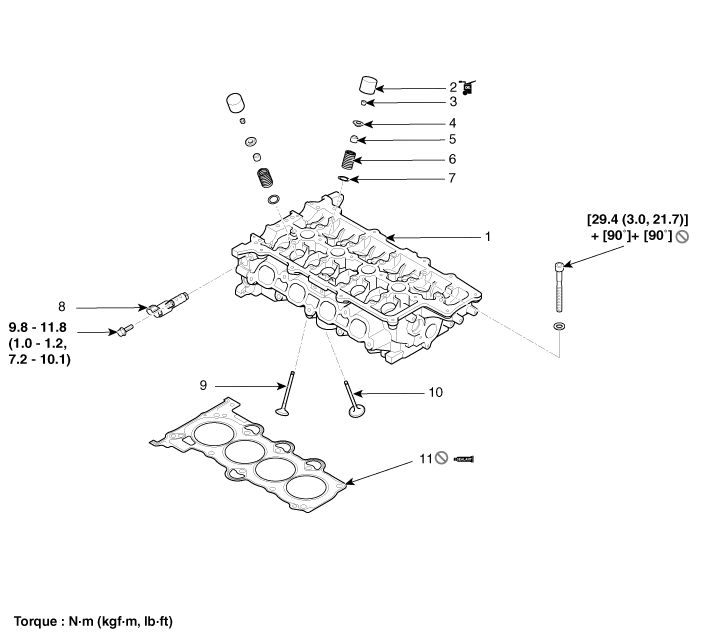
1. Cylinder head assembly
2. Mechanical lash adjuster (MLA)
3. Retainer lock
4. Retainer
5. Valve stem seal
6. Valve spring
|
7. Valve spring seat
8. Oil control valve (OCV)
9. Exhaust valve
10. Intake valve
11. Cylinder head gasket
|
Repair procedures
Engine removal is not required for this procedure.
| • |
Use fender covers to avoid damaging painted surfaces.
|
| • |
To avoid damaging the cylinder head, wait until the engine coolant
temperature drops below normal temperature before removing it.
|
| • |
When handling a metal gasket, take care not to fold the gasket
or damage the contact surface of the gasket.
|
| • |
To avoid damage, unplug the wiring connectors carefully while
holding the connector portion.
|
|
| • |
Mark all wiring and hoses to avoid misconnection.
|
| • |
Turn the crankshaft damper pulley so that the piston of No. 1
cylinder is at TDC (top dead center) on compression stroke.
|
|
| 1. |
Remove the engine cover.
(Refer to Engine and Transmission Assembly - "Engine Cover")
|
| 2. |
Disconnect the battery negative terminal.
|
| 3. |
Remove the air duct and air cleaner assembly.
(Refer to Intake and Exhaust System - "Air Cleaner")
|
| 4. |
Remove the engine room under cover.
(Refer to Engine and Transmission Assembly - "Engine Room Under Cover")
|
| 5. |
Drain the coolant.
(Refer to Cooling System - "Coolant")
|
| 6. |
Remove the intercooler inlet hose & pipe (A).
|
Tightening torque
Hose clamp bolt :
4.9 - 6.9 N·m (0.5 - 0.7 kgf·m, 3.6 - 5.1 lb·ft, 43.4 - 60.8
lb·in)
(If equipped with a cap, tighten it until the cap is removed.)
Pipe mounting Bolt :
18.6 - 23.5 N·m (1.9 - 2.4 kgf·m ,13.7 - 17.4 lb·ft)
|
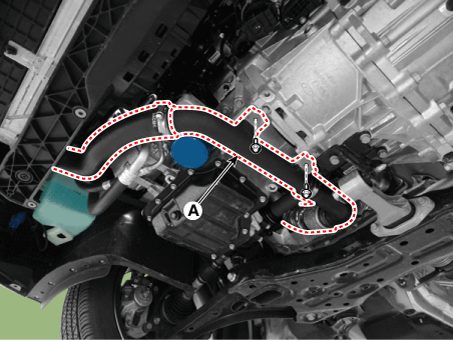
|
| 7. |
Disconnect the RCV solenoide valve connector (A) and booster pressure
sensor (BPS) connector (B).
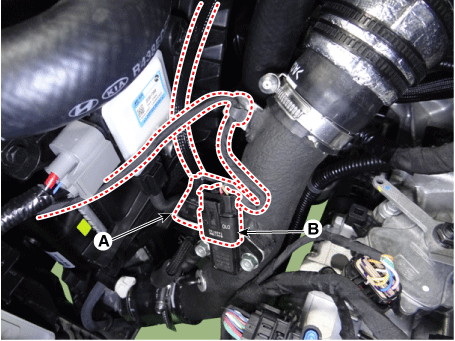
|
| 8. |
Disconnect the intercooler outlet hose (A).
|
Tightening torque :
4.9 - 6.8 N·m (0.5 - 0.7 kgf·m, 3.6 - 5.0 lb·ft, 43.4 - 60.8
Ib·in)
|
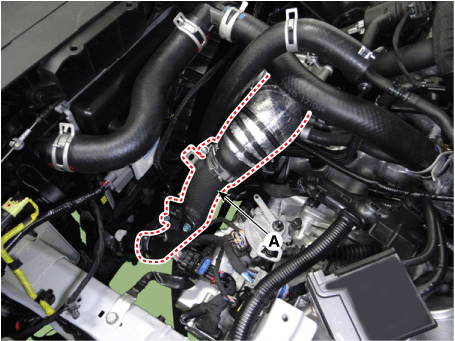
|
| 9. |
Disconnect the radiator upper hose (A).
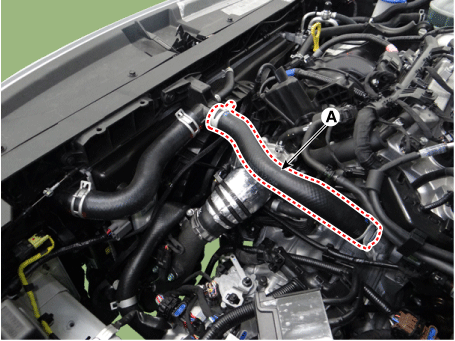
|
| 10. |
Disconnect the radiator lower hose (A).
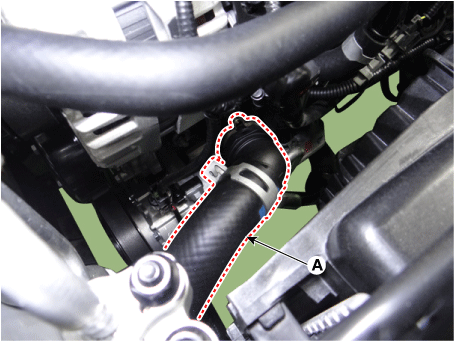
|
| 11. |
Disconnect the brake booster vacuum hose (A).
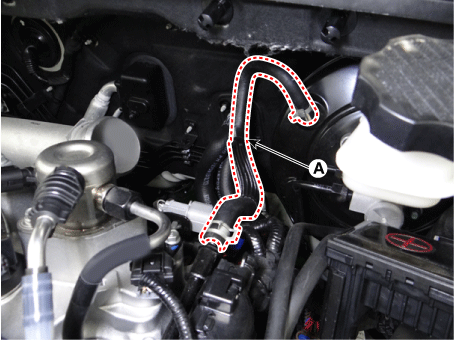
|
| 12. |
Remove the intake & exhaust CVVT oil control valve.
(Refer to Engine Control / Fuel System - "CVVT Oil Control Valve (OCV)")
|
| 13. |
Remove the vacuum pipe assembly (A).
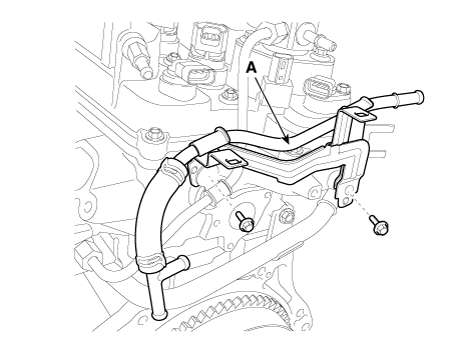
|
| 14. |
Remove the intake manifold.
(Refer to Intake and Exhaust System - "Intake Manifold")
|
| 15. |
Remove the exhaust manifold module.
(Refer to Intake and Exhaust System - "Exhaust Manifold")
|
| 16. |
Remove the delivery pipe assembly.
(Refer to Engine Control / Fuel System - "Delivery Pipe")
|
| 17. |
Disconnect the bypass hose, and then remove the water temperature control
assembly.
(Refer to Cooling System - "Water Temperature Control Assembly")
|
| 18. |
Remove the water pipe.
(Refer to Cooling System - "Water Temperature Control Assembly")
|
| 19. |
Remove the cylinder head cover.
(Refer to Cylinder Head Assembly - "Cylinder Head Cover")
|
| 20. |
Remove the exhaust oil control valve (OCV) adapter (A).
|
Tightening torque :
9.8 - 11.8 N·m (1.0 - 1.2 kgf·m, 7.2 - 8.7 lb·ft)
|
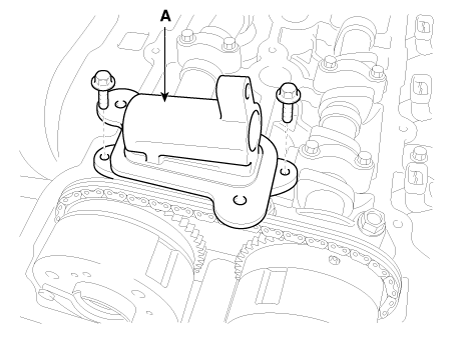
|
| 21. |
Remove the timing chain cover.
(Refer to Timing System - "Timing Chain Cover")
|
| 22. |
Remove the timing chain.
(Refer to Timing System - "Timing Chain")
|
| 23. |
Remove the intake CVVT assembly (A) & exhaust CVVT assembly (B).
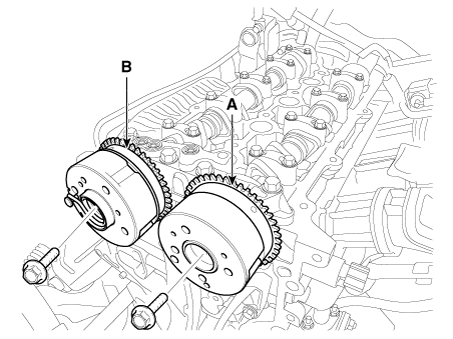
|
When removing the CVVT assembly bolt, fix the camshaft (A) using
a wrench.
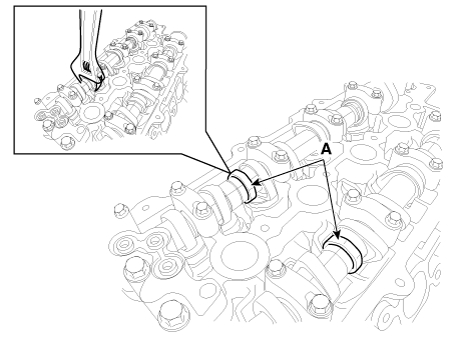
|
|
| 24. |
Remove the camshaft bearing caps (A) in the order of image below.
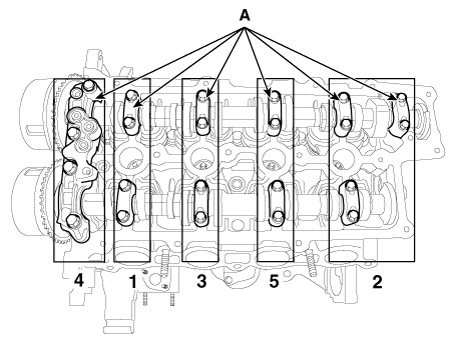
|
| 25. |
Remove the intake & exhaust camshaft (A).
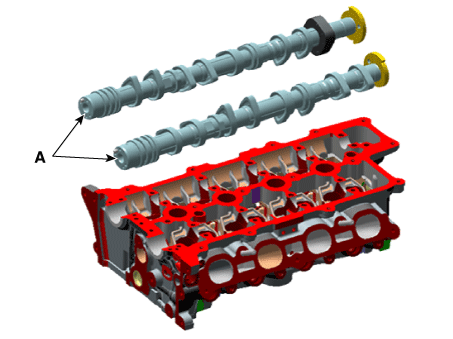
|
| 26. |
Remove the rear hanger (A).
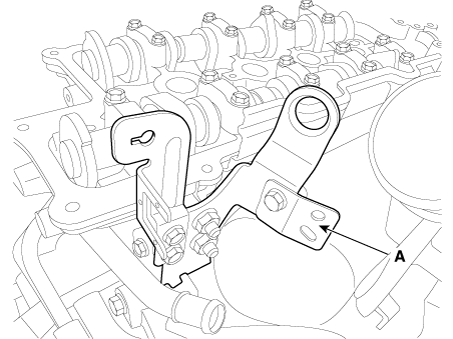
|
| 27. |
Remove the cylinder head cover heat protector (A).
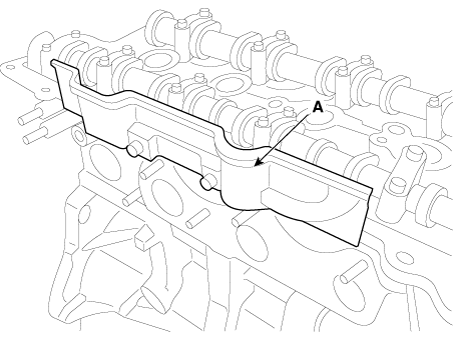
|
| 28. |
Remove the cylinder head bolts, then remove the cylinder head.
| (1) |
Uniformly loosen and remove the 10 cylinder head bolts, in several
passes, in the sequence shown.
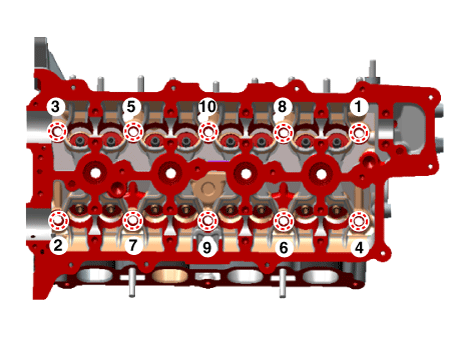
|
Head warpage or cracking could result from removing bolts
in an incorrect order.
|
|
| (2) |
Lift the cylinder head from the cylinder block and put the cylinder
head on wooden blocks.
|
Be careful not to damage the contact surfaces of the
cylinder head and cylinder block.
|
|
| (3) |
Remove the cylinder head gasket (B).
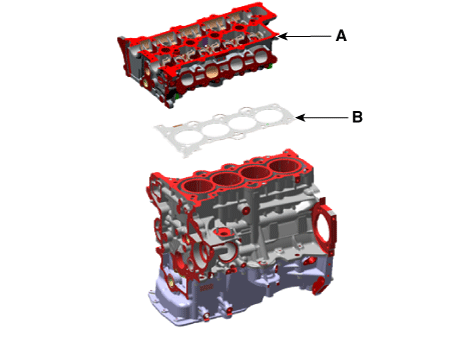
|
|
|
Identify MLA (Mechanical lash adjuster), valves, valve springs as they
are removed so that each item can be reinstalled in its original position.
|
| 1. |
Remove the MLAs (A).
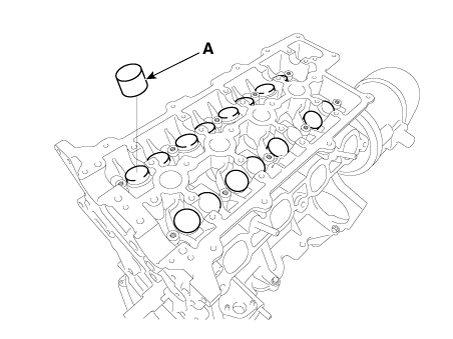
|
When removing MLAs, mark all the MLAs for their rearrangement.
|
|
| 2. |
Remove the valves.
| (1) |
Using the SST (09222-3K000, 09222-3K100), compress the valve
spring and remove the retainer lock.
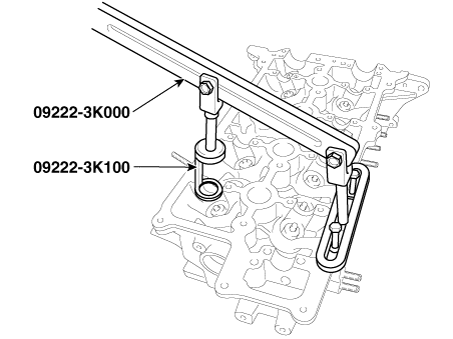
|
| (2) |
Remove the spring retainer.
|
| (5) |
Remove the valve stem seal.
|
| (6) |
Using a magnetic pickup tool, remove the spring seat.
|
Do not reuse the valve stem seals.
|
|
|
Cylinder Head
| 1. |
Inspect for flatness.
Using a precision straight edge and feeler gauge, measure the surface
the contacting the cylinder block and the manifolds for warpage.
If the flatness is greater than maximum, replace the cylinder head.
|
Flatness of cylinder head gasket surface
Standard :
Less than 0.05 mm (0.0020 in) for total area
Less than 0.02 mm (0.0008 in) for a section of 100 mm (3.9370
in) X 100 mm (3.9370 in)
|
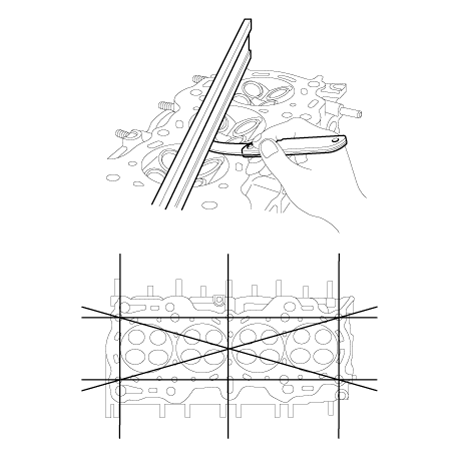
|
| 2. |
Inspect for cracks.
Check the combustion chamber, intake ports, exhaust ports and cylinder
block surface for cracks. If cracked, replace the cylinder head.
|
Valve And Valve Spring
| 1. |
Inspect the valve stems and valve guides.
| (1) |
Using a caliper gauge, measure the inner diameter of valve guide.
For valve guide inner diameter, evenly measure 5 points 2 mm
(0.0787 in) from each end of valve guide.
|
Valve guide inner diameter :
5.500 - 5.512 mm (0.2165 - 0.2170 in)
|
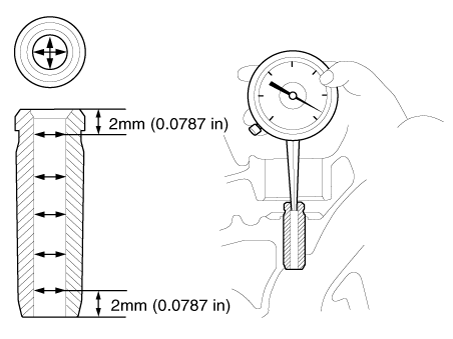
|
| (2) |
Using a micrometer, measure the outer diameter of valve stem.
|
Valve stem outer diameter
Intake : 5.465 - 5.480 mm (0.2152 - 0.2157 in)
Exhaust : 5.458 - 5.470 mm (0.2149 - 0.2154 in)
|
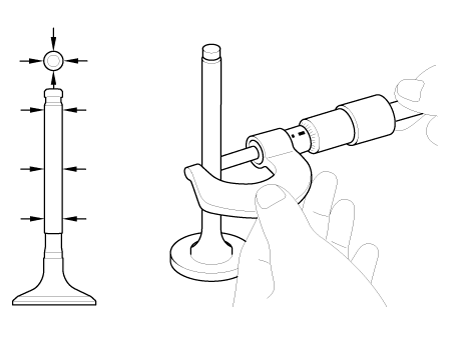
|
| (3) |
Subtract the valve stem outer diameter measurement from the valve
guide inner diameter measurement.
|
Valve stem - to - guide clearance
Intake : 0.020 - 0.047 mm (0.0008 - 0.0019 in)
Exhaust : 0.030 - 0.054 mm (0.0012 - 0.0021 in)
|
If the clearance is greater than specification, replace the valve
or the cylinder head.
|
|
| 2. |
Inspect the valves.
| (1) |
Check the valve is ground to the correct valve face angle.
|
| (2) |
Check that the surface of valve for wear. If the valve face is
worn, replace the valve.
|
| (3) |
Check the valve head margin thickness.
If the margin thickness is less than minimum, replace the valve.
|
Margin
Standard
Intake : 1.10 mm (0.0433 in)
Exhaust : 1.26 mm (0.0496 in)
|
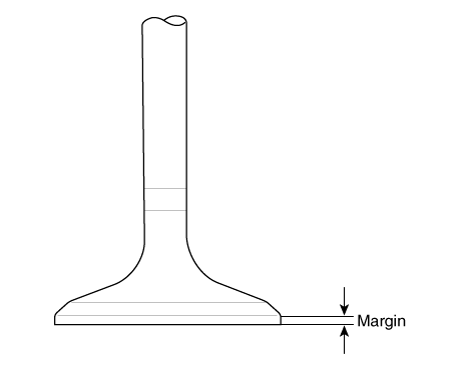
|
| (4) |
Check the length of valve.
|
Valve length
Standard
Intake : 93.15 mm (3.6673 in)
Exhaust : 92.60 mm (3.6457 in)
|
|
| (5) |
Check the surface of valve stem tip for wear. If the valve stem
tip is worn, replace the valve.
|
|
| 3. |
Inspect the valve seats.
| (1) |
Check the valve seat for evidence of overheating and improper
contact with the valve face. If the valve seat is worn, replace
the cylinder head.
|
| (2) |
Check the valve guide for wear. If the valve guide is worn, replace
the cylinder head.
|
|
| 4. |
Inspect the valve springs.
| (1) |
Using a steel square, measure the out - of - square of valve
spring.
|
| (2) |
Using a vernier calipers, measure the free length of valve spring.
|
Valve spring
Standard
Free height : 45.1 mm (1.7756 in)
Out of square : Less than 1.5°
|
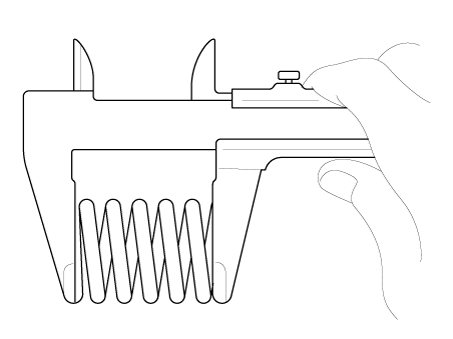
|
|
| • |
Thoroughly clean all parts to be assembled.
|
| • |
Before installing the parts, apply fresh engine oil to all sliding
and rotating surface.
|
| • |
Replace oil seals with new ones.
|
|
| 1. |
Install the valves.
| (1) |
Install the spring seats.
|
| (2) |
Using the SST (09222-2B100), push in a new oil seal.
|
• |
Do not reuse old valve stem oil seals.
|
|
• |
Incorrect installation of the seal could result
in oil leakage past the valve guides.
|
|
• |
Intake valve stem seals are different from exhaust
ones in type.
Do not reassembly ones in the other's places.
|
|
|
| (3) |
Install the valve, valve spring and spring retainer, after applying
engine oil at the end of each valve.
|
When installing valve springs, the enamel coated side
should face the valve spring retainer.
|
|
|
| 2. |
Using the SST (09222-3K000, 09222-3K100), compress the spring and install
the retainer locks.
After installing the valves, ensure that the retainer locks are correctly
in place before releasing the valve spring compressor.

|
When installing the SST, use the torque, 1.2kgf.m or less.
|
|
| 3. |
Lightly tap the end of each valve stem two or three times with the wooden
handle of a hammer to ensure proper seating of the valve and retainer lock.
|
| 4. |
Install the MLA (Mechanical lash adjuster).
Check that the MLA (A) rotates smoothly by hand.

|
All the MLAs must be installed in its original position.
|
|
| • |
Thoroughly clean all parts to be assembled.
|
| • |
Always use new cylinder head gasket and manifold gaskets.
|
| • |
Always use new cylinder head bolts. Cylinder head bolts are torque
- to - yield bolts designed to be permanently elongated beyond the
state of elasticity when torqued, so if the bolts are removed and
reused, it may cause the bolts to break or fail to maintain clamping
force.
|
| • |
The cylinder head gasket is a metal gasket. Take care not to
bend it.
|
| • |
Rotate the crankshaft, set the No.1 piston at TDC.
|
|
| 1. |
Install the cylinder head assembly.
| (1) |
Before installing, remove the hardened sealant from the cylinder
block and cylinder head surface.
|
| (2) |
Before installing the cylinder head gasket, apply sealant on
the upper surface of the cylinder block and reassemble the gasket
within five minutes.
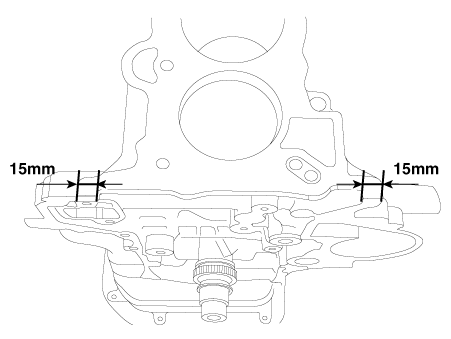
|
Refer to the illustration for applying sealant.
|
|
Width :
2.0 - 3.0 mm (0.0787 - 0.1181in.)
Position :
1.0 - 1.5 mm (0.0394 - 0.0591in.)
Specification : TB 1217H or LOCTITE 5900H
|
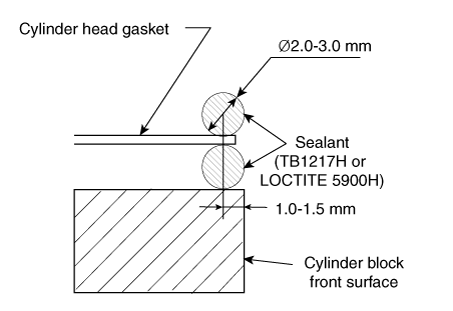
|
| (3) |
After installing the cylinder head gasket on the cylinder block,
apply sealant on the upper surface of the cylinder head gasket and
reassemble in five minutes.
|
|
| 2. |
Place the cylinder head carefully not to damage the gasket.
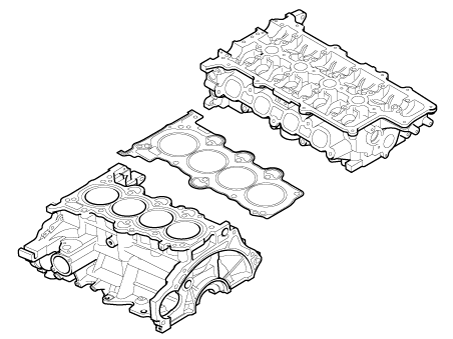
|
| 3. |
Install the cylinder head bolts with washers.
| (1) |
Tighten the 10 cylinder head bolts, in several passes, in the
sequence shown.
|
Tightening torque :
29.4 N·m (3.0 kgf·m, 21.7 lb·ft) + 90° + 90°
|
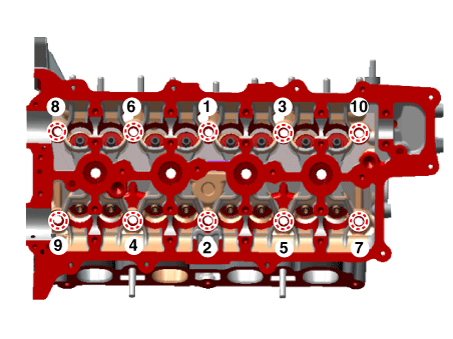
|
Always use new cylinder head bolts. Cylinder head bolts
are toque - to - yield bolts designed to be permanently
elongated beyond the state of elasticity when torqued, so
if the bolts are removed and reused, it may cause the bolts
to break or fail to maintain clamping force.
|
|
|
| 4. |
Apply the engine oil to the journal before installing the cam shaft.
|
| 5. |
Install the intake & exhaust cam shaft (A).

|
| 6. |
Install the cam shaft bearing cap (A) in the order below.
|
Tightening torque
M6 bolts :
11.8 - 13.7 N·m (1.2 - 1.4 kgf·m, 8.7 - 10.1 lb·ft)
M8 bolts :
18.6 - 22.6 N·m (1.9 - 2.3 kgf·m, 13.7 - 16.6 lb·ft)
|
|
| 7. |
Install the intake CVVT assembly (A) and the exhaust CVVT assembly (B).
|
Tightening torque :
63.7 - 73.5 N·m (6.5 - 7.5 kgf·m, 47.0 - 54.2 lb·ft)
|
|
When installing the CVVT assembly, fix the cam shaft using wrench.

|
|
| 8. |
Install the cylinder head cover heat protector (A).
|
Tightening torque :
9.8 - 11.8 N·m (1.0 - 1.2 kgf·m, 7.2 - 8.7 lb·ft)
|

|
| 9. |
Install the rear engine hanger (A).
|
Tightening torque :
18.6 - 23.5 N·m (1.9 - 2.4 kgf·m, 13.7 - 17.4 lb·ft)
|

|
| 10. |
Install the timing chain.
(Refer to the Timing System - “Timing Chain”)
|
| 11. |
Install other parts in the reverse order of removal.
|
Components and components location
Components
1. Exhaust camshaft
2. Intake camshaft
3. Exhaust CVVT
4. Intake CVVT
5. Camshaft bearing cap
6. Camsha ...
Components and components location
Components
1. Drive
belt
2. Idler
3. Tension adjust bolt
4. Drive
belt tensioner
5. Crankshaft damper pulley
...
Other information:
Components and components location
Components
1. Left remote control switch
(Audio + Bluetooth + Voice)
2. Right remote control switch
(Trip Computer + SCC)
Schematic diagrams
Circuit Diagram
[Audio + Bluetooth + Voice]
...
Service in
It calculates and displays (in mileage
or days) when you need a scheduled
maintenance service.
If the remaining mileage or time
reaches 1,500 km (900 mi.) or 30
days, a “Service in” message is displayed
for several seconds each time
you set the ignition switch or Engine ...

 CVVT & Camshaft
CVVT & Camshaft Drive Belt System
Drive Belt System




























